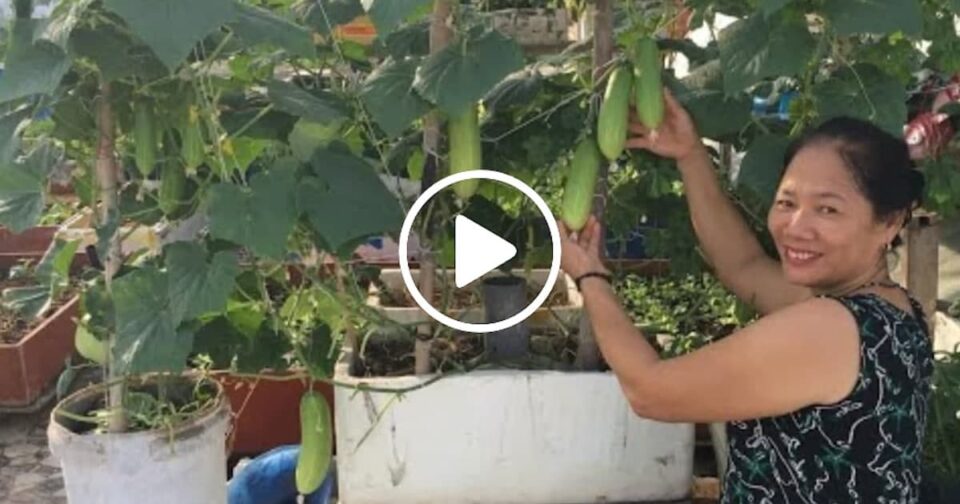Although cucumbers have sprawling vines, you can grow them in containers. The key is to choose a compact variety and train those vines up a trellis. The crop climbs high, conserving space and harvesting is a breeze. In addition, growing in containers is a great way to give cucumbers the extra heat they love and control moisture and fertility.

Getting Started: Cucumbers are members of the Cucurbitaceae family, which includes summer squash, winter squash, gourds, and melons. Like their relatives, cucumbers are heavy feeders.
They require warmth, fertile soil, and consistent moisture. In sunny, windy, or hot urban areas, plants in containers tend to dry out quickly, but there are simple ways to keep your plants from getting thirsty.

Use a large container. Cucumbers need large pots with plenty of soil, so they can develop extensive root systems to support vigorous growth and abundant crops.
Choose a container that holds at least 5 gallons (or 20 quarts) of soil for each plant; a larger container is even better.

Self-watering planters are especially good for cucumbers because they provide some insurance against drying out. Because of the built-in reservoir, self-watering planters don’t dry out as quickly. You’ll still need to monitor the moisture level, but you’ll have more time between waterings.
Use good quality potting soil. Rich, healthy soil will keep your plants well-fed and retain more moisture than poor-quality soil. Do not use ordinary garden soil, which does not drain well when used in a container.
Choose a compact variety. Read the seed packets to identify the best choices for small-space gardening. Several varieties are listed below.
Don’t plant too early. Cukes are hot-weather plants. Don’t plant outdoors until the weather is warm. usually a week or two after the last spring frost. To get a jump-start, you can start seeds indoors for a couple of weeks before putting them outside. Use biodegradable pots to prevent transplant shock. Pop-up covers can also help extend the season.

Use a trellis. Take advantage of the vining habit of cucumbers and make use of vertical space. Even a tomato cage can serve as a trellis.
Feed your plants regularly. Amend the soil with granular fertilizer at planting time and follow up with liquid fertilizer during the growing season.
Check the soil moisture every morning. The best way to keep container plants healthy? Develop a good watering sense. Always check the soil moisture with your finger before watering. If dry, water thoroughly. If wet, don’t water again until the soil feels dry on top and remains slightly moist below the surface.

Note: Plants use the most water during the day when they’re actively photosynthesizing and transpiring (releasing water from their foliage), so water in the morning, unless it’s going to rain.
Pests and diseases
Cucumbers are easy to grow and generally don’t have many problems. But there are a few things to watch for:

Powdery mildew: Looks like white powder sprinkled on the leaf surfaces. It usually happens when conditions are humid and when the plants are stressed; providing good air circulation helps prevent it.

If you spot the disease, remove any severely affected leaves and try either of these two homemade solutions:
- Mix 1 teaspoon of baking soda with 1 drop of dish soap and 1 quart of water and spray on the plants. It raises the pH of leaf surfaces, making them less attractive to spores.
- Mix 1 part cow’s milk with 9 parts water and use the mixture as a foliar spray after each rain. The enzymes in the milk are said to discourage the fungus.
Cucumber beetles and squash bugs: These are the most common pests of cucurbits. The yellow and black cucumber beetles have big appetites and move quickly — but you can spray them with neem oil (or vacuum them) and destroy the orange eggs they lay on the underside of leaves.

Squash bugs are large, brown shield-shaped bugs, but they’re quite slow-moving, making them easy to pick off and drop into a container of soapy water. Managing these pests also helps prevent diseases, because insects are often carriers of disease.
TIP: Cover new seedlings with garden fabric or covers until they start to flower.
If you notice that the first group of flowers that appears simply drops off and doesn’t produce fruit, be patient. The first flowers of the season are often males. Female flowers (which have a slight bulge at their base) will start to appear soon after.
Best varieties for containers
In urban areas where there are few bees, choose varieties that are parthenocarpic, which means they set fruit without pollination. Seeds for these varieties are available from High Mowing Organic Seeds.

Picolino F1: A European slicer with sweet flavor, thin skin, and crispy texture. Parthenocarpic, with fruit maturing in 50 days.
Saber F1: An American slicer with 8″-9″ fruit that matures in 55 days. No pollination is required.
H-19 Little Leaf: No pollination is required for this pickling variety, which produces 3″-4″ fruit in about 58 days.
Paraiso F1: A slicer with 8″-10″ fruit. High-yielding at 59 days.
National Pickling: The 5″ fruits, with blunt ends, are perfect for pickling. Starts fruiting at 52 days. Also delicious in salads.
Poona Kheera: This unusual variety from India has 4″5″ fruit with golden skin and a juicy, crisp texture. Very productive, starting at 50 days. Climbs easily on a trellis to 5 or 6 feet.
PLEASE WATCH THE VIDEO BElOW:
